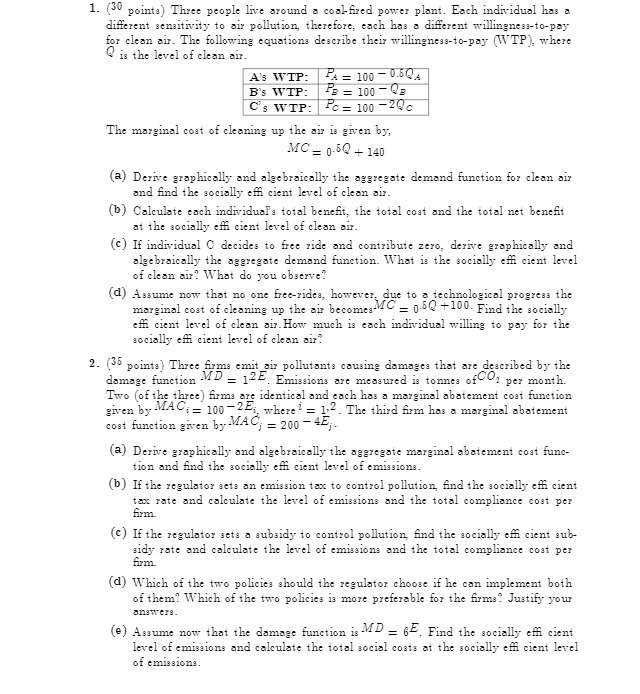
1. (30 points) Three people live around a coal- fired power plant. Each individual has a different sensitivity to air pollution, therefore, each has a different willingness-to-pay for clean air. The following equations describe their willingness-to-pay (WTP), where @ is the level of clean air. A's WTP: FA = 100 - 0.5QA B's WTP: = = 100 - QB C's WTP: Fo = 100 -20c The marginal cost of cleaning up the air is given by, MO = 0-5@ + 140 (@) Derive graphically and algebraically the aggregate demand function for clean air and find the socially effi cient level of clean air. (b) Calculate each individuala total benefit, the total cost and the total net benefit at the socially effi cient level of clean air. (c) If individual O decides to free ride and contribute zero, derive graphically and algebraically the aggregate demand function. What is the socially effi cient level of clean air? What do you observe (@) Assume now that no one free-rides, however, due to a technological progress the marginal cost of cleaning up the air becomes- = 0.50 +100. Find the socially effi cient level of clean air How much is each individual willing to pay for the socially effi cient level of clean air? 2. (35 points ) Three firms emit air pollutants causing damages that are described by the damage function - = 125. Emissions are measured is tonnes of per month. Two (of the three) firms are identical and each has a marginal abatement cost function given by MAC:= 100 -25. where'= 1:2. The third firm has a marginal abatement cost function given by MAC, = 200 - 4E;. (a) Derive graphically and algebraically the aggregate marginal abatement cost func- tion and find the socially effi cient level of emissions. (b) If the regulator sets an emission tax to control pollution, find the socially effi cient tax rate and calculate the level of emissions and the total compliance cost per firm (C) If the regulator sets a subsidy to control pollution, find the socially effi cient sub- aidy rate and calculate the level of emissions and the total compliance cost per firm (d) Which of the two policies should the regulator choose if he can implement both of them? Which of the two policies is more preferable for the firms? Justify your answers. (e) Assume now that the damage function is - = 6-. Find the socially effi cient level of emissions and calculate the total social costs at the socially effi cient level of emissions








